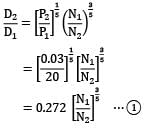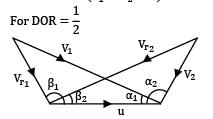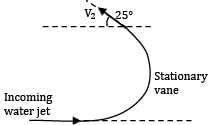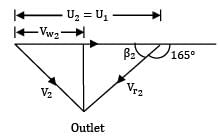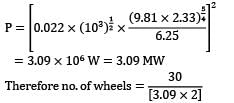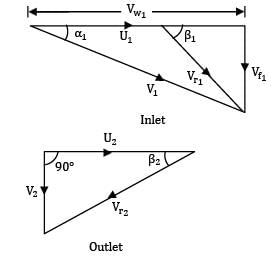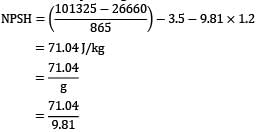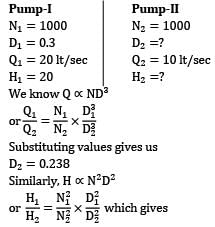Test: Hydraulic Machines Level - 2 - Civil Engineering (CE) MCQ
20 Questions MCQ Test - Test: Hydraulic Machines Level - 2
A radial flow hydraulic turbine is required to be designed to produce 20 MW under a head of 16 m at a speed of 90 rpm. A geometrically similar model with an output of 30 kW and a head of 4 m is to be tested under dynamically similar conditions. What is the required impeller diameter ratio between the model and prototype?
Which one of the following statements is correct with respect to axial flow 50% reaction turbine?
A water jet impinges tangentially at one tip of a stationary vane having an inlet angle of zero degree and an outlet angle 25 degree. The incoming velocity of jet is 50 meters per second. Determine the component of force acting on the vane in the direction of jet velocity. Assume water flow equivalent to 1 kg/s.
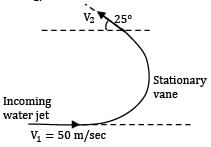

Which of the following statements are correct?
1. The specific speed of a turbine is the speed at which a geometrically similar turbine develops unit power under the unit head at its maximum efficiency.
2. The specific speed is dimensionless parameter used for the selection of turbines.
3. The function of guide vanes in reaction turbines is to minimize shock at entry of the fluid onto the runner blades.
Select the correct answer using the code given below.
A centrifugal pump lifts 0.0125 m3⁄s of water from a well with a static lift of 30 m. If the brake power of the driving electric motor is 5 kW, what is the overall efficiency of the pump-set?
Mainly hydraulic turbines are used to drive the electrical alternators which require maintaining the peripheral speed constant even at part load conditions to avoid the change in frequency of electric power. The governing of the hydraulic turbine is done by
The hydraulic efficiency of a turbine is the ratio of
In axial flow pumps and compressors the combined velocity diagram with common base is used to determine change in
Consider the following statements. 1. The distinguishing features of radial flow reaction turbines are: (i) Only a part of the total head of water is converted into velocity head before it reaches the runner. (ii) The flow-through water completely fills all the passages in the runner. 2. Kaplan turbine is essentially a propeller working in reverse, and its blades are so mounted that all the blade angles can be adjusted simultaneously by means of suitable gearing even as the machine is in operation. 3. A draft tube is a pipe of gradually increasing cross-sectional area which must be airtight, and under all conditions of operation, its lower end must be submerged below the level of the discharged water in the tailrace.
Which of the above statements are correct?
The mean bucket speed of a Pelton turbine is 15 m/s. The rate of flow of water supplied by the jet under a head of 42 m is 1 m3 /s. If the jet is deflected by the buckets at an angle of 165°, find the power of the turbine. (in kW). (Take coefficient of velocity (Cv = 0.985).
Consider the following advantages of rotary pumps compared to reciprocating pumps:
1. Steady discharge which increases with decrease in head
2. Suitable for handling fluids with suspended solid particles
3. Less bulky than positive displacement pumps 4. Can be started with open delivery with least load
Which of the above advantages are correct?
Statement I: The speed of a governed water turbine will remain constant irrespective of load.
Statement II: In governing, the water supply is regulated to maintain the speed constant.
A single jet Pelton turbine is required to drive a generator to develop 10 MW. The available head at the nozzle is 762 m. Assuming electric generator efficiency 95%, Pelton wheel efficiency 87%, coefficient of velocity for nozzle 0.97, mean bucket velocity 0.46 of jet velocity, outlet angle of the buckets 15° and the friction of the bucket reduces the relative velocity by 15%, find the diameter of the jet (in mm), if the ratio of mean bucket circle diameter to the jet diameter is not to be less than 10.
In a hydroelectric scheme a number of Pelton wheels are to be used under the following conditions: Total output required 30 MW; gross head 245 m; speed 6.25 rev/s; 2 jets per wheel; Cv of nozzles 0.97; maximum overall efficiency (based on conditions immediately before the nozzles) 81.5%; dimensionless specific speed not to exceed 0.022 rev. per jet; head lost to friction in pipeline is 12 m. Ratio of blade to jet speed is 0.46.
Calculate the number of wheels required.
Consider the following statements with regard to hydraulic turbines:
1. Kaplan turbines are most efficient at part load operations.
2. If n is the number of jets in a Pelton turbine, then the specific speed is proportional to n2.
3. The flow ratio of Francis turbines are in the range of 0.1-0.3.
Which of the above statements is/are correct?
A Francis turbine has a diameter of 1.4 m and rotates at 430 rpm. Water enters the runner without shock with a flow velocity of 9.5 m/s and leaves the runner without whirl with an absolute velocity of 7 m/s. The difference between the sum of the static and potential heads at entrance to the runner and at the exit from the runner is 62 m. The turbine develops 12.25 MW. The flow rate through the turbine is 12 m3/s for a net head of 115 m.
Find the absolute velocity of water at entry to the runner and the angle of the inlet guide vanes.
Calculate the net positive suction head (NPSH) of a centrifugal pump using the following data. Vapour pressure of the liquid = 26.66 kN/m2 .
Distance between the level of liquid in the reservoir and suction line = 12. m.
Density of the liquid = 865 kg/m3 Friction in the suction line = 3.5 J/kg Reservoir is open to the atmosphere.
Statement I: Cavitation occurs at the entrance of the turbine while it occurs at the exit of the pump.
Statement II: In both the cases local pressure at these points falls below the vapour pressure of the flowing liquid.
Two geometrically similar pumps are running at 1000 rpm speed (both). If one pump has impeller diameter of 0.3 m and discharges 20 lt/sec against 20 m head, and the other pump gives half of this discharge rate; calculate the head and diameter of second pump.
A centrifugal pump is fully primed, but on starting it fails to deliver fluid. The probable reasons are listed below:
1. Leaky foot valve or suction line
2. Suction head is very low
3. Insufficient motor speed
4. Damaged or closed delivery valve
Which of these reasons are correct?


